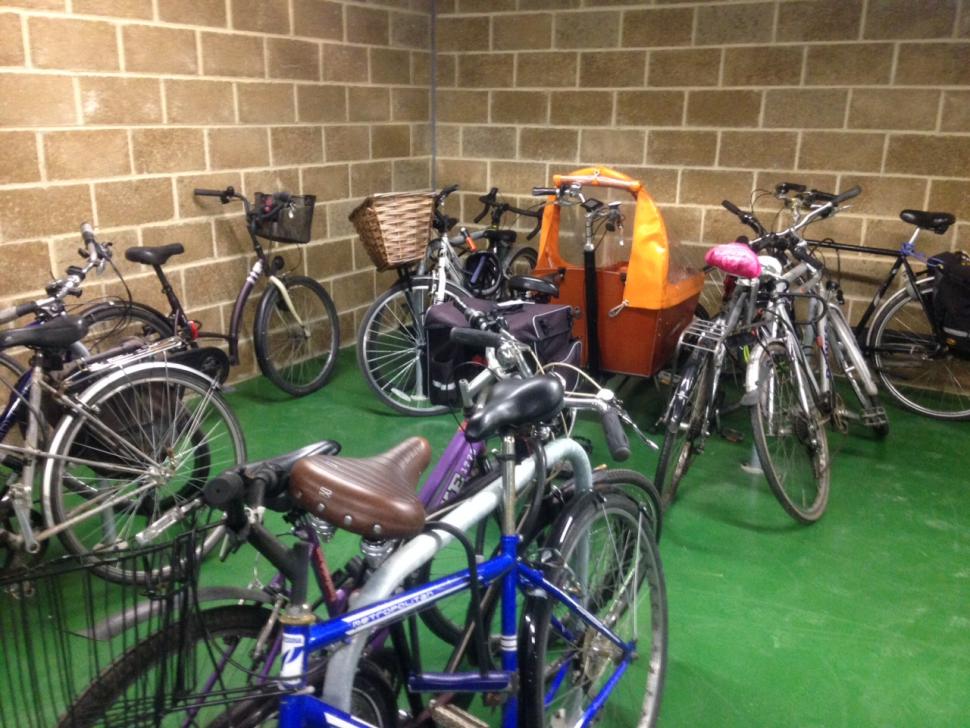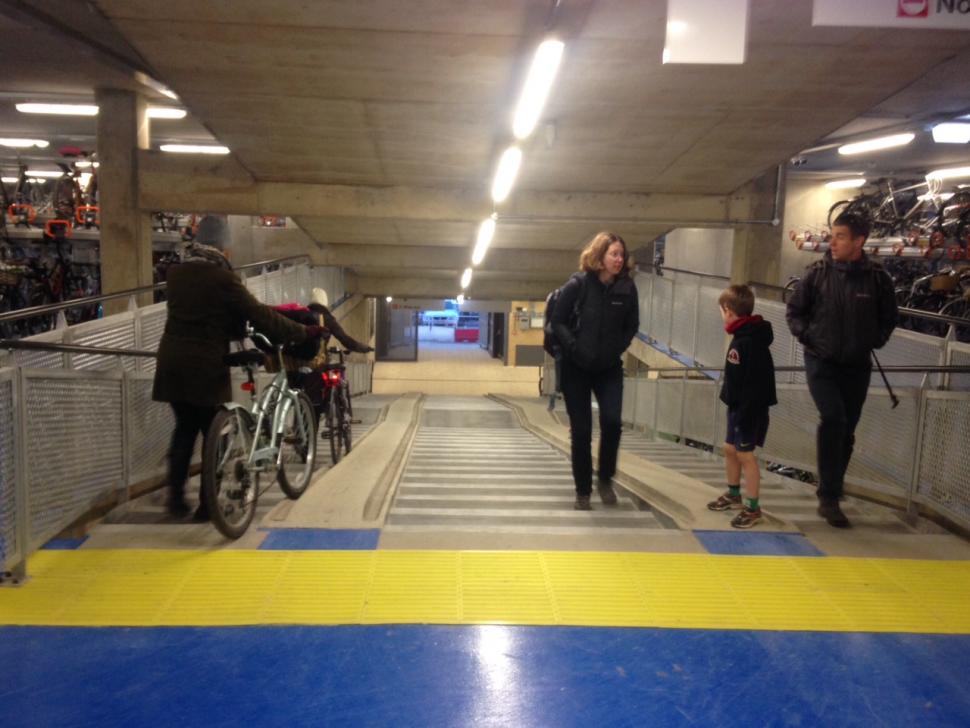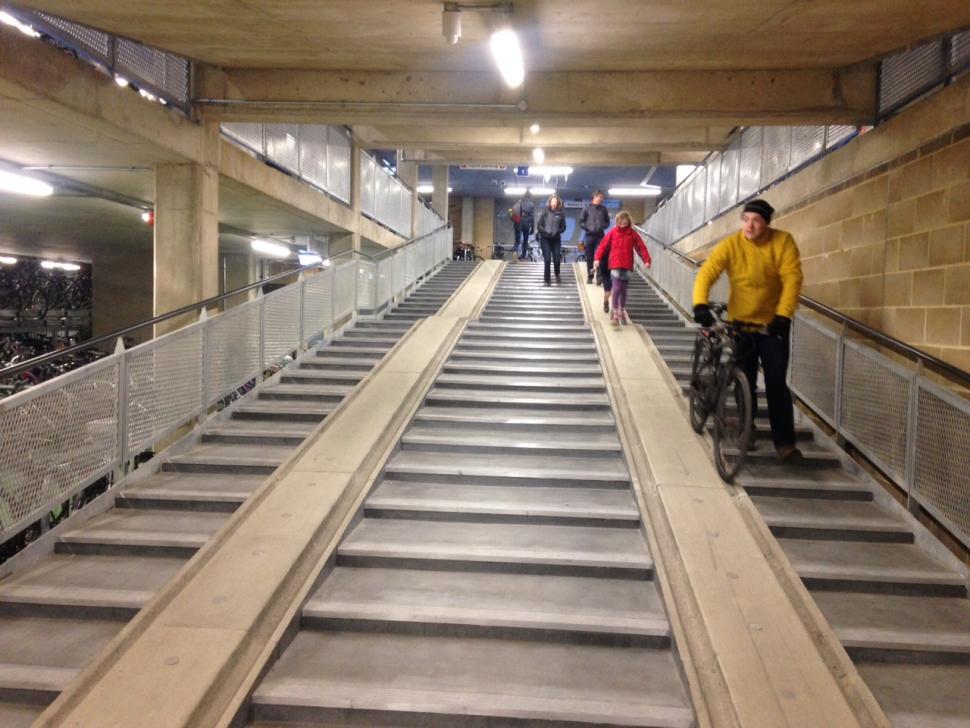- News
- Reviews
- Bikes
- Accessories
- Accessories - misc
- Computer mounts
- Bags
- Bar ends
- Bike bags & cases
- Bottle cages
- Bottles
- Cameras
- Car racks
- Child seats
- Computers
- Glasses
- GPS units
- Helmets
- Lights - front
- Lights - rear
- Lights - sets
- Locks
- Mirrors
- Mudguards
- Racks
- Pumps & CO2 inflators
- Puncture kits
- Reflectives
- Smart watches
- Stands and racks
- Trailers
- Clothing
- Components
- Bar tape & grips
- Bottom brackets
- Brake & gear cables
- Brake & STI levers
- Brake pads & spares
- Brakes
- Cassettes & freewheels
- Chains
- Chainsets & chainrings
- Derailleurs - front
- Derailleurs - rear
- Forks
- Gear levers & shifters
- Groupsets
- Handlebars & extensions
- Headsets
- Hubs
- Inner tubes
- Pedals
- Quick releases & skewers
- Saddles
- Seatposts
- Stems
- Wheels
- Tyres
- Health, fitness and nutrition
- Tools and workshop
- Miscellaneous
- Buyers Guides
- Features
- Forum
- Recommends
- Podcast
Cambridge Railway Station's new CyclePoint opens (+ gallery)
Cyclists in Cambridge have welcomed the opening on Monday of Britain’s largest dedicated cycle parking facility – although there have reportedly been some teething difficulties.
Located next to the city’s railway station in a building that will eventually house a Hotel Ibis, still under construction, there are currently more than 1,500 spaces available on the ground floor, all of them free to use.
From next month that will increase to a full capacity of 2,850 cycle parking spaces, and by April a bike shop will follow, operated by Rutland Cycling, which recently bought Cambridge-based Station Cycles.
> Rutland Cycling buys four Cambridge bike shops
The facility, which is covered by CCTV as well as manned security patrols, was commissioned by station operator Abellio Greater Anglia, a subsidiary of Dutch railway operator Nederlandse Spoorwegen.
Occupying three floors - access to each of them is via ramps - it is open 24 hours a day, seven days a week includes a combination of Sheffield stands and two-tier FalcoLevel Premium + racks, which meet the Dutch national ‘FietsParkur’ standard for secure cycle parking.
There is also a dedicated area on the ground floor for bicycles such as cargo bikes or tandems that are not suitable for parking elsewhere in the facility.
Some cyclists trying out the new premises yesterday are reported to have had problems with the two-tier racks, although Falco says that those issues should ease with use.
Roxanne De Beaux, campaigns officer at Cambridge Cycling Campaign, told Cambridge News: "This will definitely help. When I first moved to Cambridge, I commuted every day and had to take my bike on the train because there were never enough spaces.
"I just arrived to give it a go. I found it a bit challenging the first time. Lifting the bike and getting it into the racks requires a bit of strength."
But Falco’s Lionel O’Hara said the issue would be a temporary one: “These particular stands are gas assisted,” he explained. “At the moment, they are all a bit stiff but, with use, pulling them out will become a lot easier."
Another cyclist, Steve McAllaister, said he had encountered problems trying to secure his bike to the upper tier of the rack, saying: "It is alright, but I can't actually lock the frame my bike to the rails, only the wheel. It's not ideal. It does concern me in security terms. I'm sure they have CCTV, but it is a bit weird."
On the whole, however, the reception has been a positive one, with Cambridge Cycling Campaign chair Martin Lucas-Smith saying: "I think it is fantastic. I commute to London at least once a week, so I am looking forward to using this. Both types of rack here work well.
"Until recently, there had been a dilapidated parking area for bikes. It was a bit dingy. There were 700 spaces and well over double that number of bikes. At long last, people know they won't have to struggle for spaces."
While construction of the Hotel Ibis continues, with completion expected in June, access to and from the CyclePoint will be via temporary access tunnels in the external scaffolding of the building.
The former temporary cycle parking near the station closed at 10pm on Monday evening and bikes left there are being removed by Abellio Greater Anglia and will be donated to charity if not claimed through the station’s customer service desk within a week.
Given it is currently the school half-term holidays in Cambridgeshire, that narrow window has proved controversial, as we reported earlier this month.
> Fiasco warning over Cambridge station CyclePoint
Simon joined road.cc as news editor in 2009 and is now the site’s community editor, acting as a link between the team producing the content and our readers. A law and languages graduate, published translator and former retail analyst, he has reported on issues as diverse as cycling-related court cases, anti-doping investigations, the latest developments in the bike industry and the sport’s biggest races. Now back in London full-time after 15 years living in Oxford and Cambridge, he loves cycling along the Thames but misses having his former riding buddy, Elodie the miniature schnauzer, in the basket in front of him.
Latest Comments
- mattw 2 sec ago
The road is an in-out No Motor Vehicles Except Access loop with no vehicle access in the middle of the loop ie effectively a crescent....
- cyclisto 18 min 12 sec ago
I understand that if it is on sale, most likely it will be sold. I am just trying to understand its benefits....
- DJameson 26 min 19 sec ago
My regular Aldi is urban, and the bike racks are heavily used and fantastic. I appreciate that they're right outside the plate glass, so any...
- Rendel Harris 33 min 18 sec ago
So, just as an example, what had five-month-old twins Naeim and Wissam Abu Anza, killed in an Israeli airstrike on a civilian house, done in their...
- Rod Marton 55 min 58 sec ago
The good news is that GWR no longer insist on bike bookings. Though this doesn't solve all the other issues with carrying bikes on GWR trains....
- Steve K 1 hour 28 min ago
On the subject of other vehicles blocking cycle lanes, there is a point on the Croydon Tram between Waddon and West Croydon where it is designed in...
- daccordimark 1 hour 41 min ago
I've had one of these since November and agree it's good value for money. For me, the ride is a bit harsh and I can't really detect any comfort...
- mark1a 2 hours 12 min ago
I tried something similar with some timber and a pair of Delta hitches, with (unlike yourself) limited success, and so for people like myself with...
- David9694 12 hours 17 min ago
You and a friend have won first prize, a day out at Diddly Squat Farm.
- matthewn5 12 hours 23 min ago
Does not compute! If you ride a lot you're going to be boiling your chain every week or every fortnight.






















Add new comment
7 comments
In response to A V Lowes comments, unfortunately you are miss-informed on most of the points you make:
a) Re- the trial - the preferred design was chosen for the previous outdoor bike storage and is now being removed because it was such poor quality. The FalcoLevel Premium+ two tier racks being used now have been developed in the 2 years it has taken for the project to come to fruition, so infact you are getting a better product.
b) In NL these units are used mainly for utility cycles with rear wheel 'nurses' locks and the issue of locking points disappears - incorrect they are for any bike.
d) Most Dutch utility bikes also have an integral bike stand, - this is true but it is still relatively easy to do this holding your bike with one hand and pulling down the upper rack with the other. Alternatively use a lower rack.
e) The two-tier was the only solution to fitting in the quantities specified in this available space, which also includes 20% for cargo and oversized bikes.
f) You cannot compare Holland and the UK, however two tier stands are used at virtually every rail station in Holland plus if you look closely in your own town there are numerous Hi-Lo 'FalcoCam' stands we designed based on the Dutch concept. Plus it's not necessarily cheaper.
g) Re - aisle sizes - again you can only design with what space is available and provide and OPTIMUM soultion for the design constraints in any given situation. The next time you do a project at home just list the constraints (money, space, other stakeholders etc etc.) and you will see for yourself, it is no different here.
h) Regarding manual handling, the upper racks have gas assist and can be lifted with one finger with a bike in them , the only heavy thing is your own bike, if you have difficulty with lifting then try and use a lower rack. Quoting the HASW Act and threatening American style claim culture devalues your whole peice, as does a very cynical and disengenuous final comment.
I have been in this job now for 10 years and we all know nothing is perfect but despite this I know that most people involved in delivering these projects try their hardest to provide the best they possibly can often under very difficult circumstances, I am constantly amazed at how cyclists seem only able to have negative comments. This is an amazing facility - celebrate it!
Jeremy Green, MD of Falco UK Ltd, manufacturer of the cycle racks (daughter of a Dutch company Falco BV).
Feel free to call me to discuss any point - our contact details are on our website www.falco.co.uk.
Is it true that "access to each of them is via ramps"? Why are there no pictures of the ramps? I can only see stairs with wheeling channels.
I think that those are the ramps. Not stairs, therefore ramps (although, as you say, "wheel channels" might be a better description). You can't actually ride all the way up to the parking area (come on - what do you think this is? some sort of multi storey car park for bicycles? oh, wait a minute...). Personally, I can't help but think that lifts might have been a better option...?
That is pretty impressive, even if there are some problems.
There was a trial of 4 types of 2-tier rack in advance of this project at Cambridge Station, and it is interesting to note that the preferred design has not been used. This design has a locking rail with a rubbing strip to avoid damage to paint on the bike and cycle stand, and would have dealt with the problems noted by those parking UK-style with D locks etc. In NL these units are used mainly for utility cycles with rear wheel 'nurses' locks and the issue of locking points disappears.
Most Dutch utility bikes also have an integral bike stand, so that you park the bike on the bike stand and then pull down the upper tray, before putting the bike on it. Without a bike stand on the bike a cycle user has a messy juggling act to hold the bike - possibly with panniers making it hard to hold upright with one hand, whilst reaching at a stretch to pull out the upper tray....
There is not really any great gain in parking density between using a 2-tier system , correctly installed with the wide aisles required to load bikes safely as specified by Fietsparkeur standards (limiting the unaided lift for front wheel on to tray to 37cm) and high density racks with no moving parts (and thus much cheaper), where 26 bikes can fit onto a space 3 metres x 5 metres with much narrower access aisles, and no lifting of trays. A recent study visit to mainland Europe saw many in the group surprised to see so little use of 2-tier stands for open public parking, and far greater use of of hi-lo staggered bike parking which neatly stored bikes at <20cm spacing, whilst leaving every bike accessible without having to remove another bike. Perhaps this is because its cheaper and just as space efficient?
Meantime I've seen drawings of a 2-tier bike parking installation with an aisle between opposing rows shown as 1.7m wide! To put this in context this makes it impossible to line-up a bike (1.8-2.0m long) to wheel straight in to the LOWER racks, and barely gives enough room to pull down the upper tray. You cannot then load the upper tray as the design requires, by lifting in the front wheel and wheeling the bike up the tray, but instead the bike has to be lifted, at an angle of around 45 degrees from being flat on the ground, and with the bike lifted the cycle user has to turn 90 degrees to place it on the tray. Reading the HSC Regulations for manual handling and applying the weight and holding points to lift up a typical bike, some cyclists will be outside the limits for safe lifting of heavy loads, and could easily consider a Section 3 (HSAW 1974) action if they are injured lifting a bike.
Oh well just another 20-30 years for UK to catch up?
And why is everyone walking their bikes down?
Much more fun to line up your wheels with the bike ramp tramlines and get down in the drops and go for it, with a skid turn to stop, surely?
Please note, I'm not really suggesting anyone try it before I get flamed for promoting dangerous and anti social behaviour.
Is this parking really free, or will it become a chargeable service after everyone's got used to it?